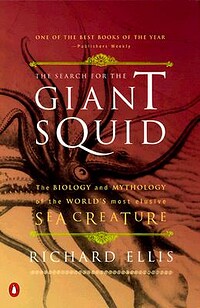Call number
Publication
Pages
Description
The most mysterious and elusive of all sea creatures, the giant squid -at least sixty feet long and weighing more than a ton- is also one of the largest. With two whip-like tentacles, eight arms studded with toothed suckers, and two lidless eyes the size of dinner plates, Architeurthishas inspired myths and movies, nightmares and religious conversions. Yet it has never been studies while alive. Marin biologist, explorer, and artist Richard Ellis delves into myth, literature, and science to bring readers face-to-face with this remarkable creature as it terrifies sailors ad fishermen throughout history and battles for its life against the great sperm whale. Ellis continues his exploration into the modern era, when scientists rush to study a rare carcass, and the giant squid is a staple on the big screen. Interweaving his narrative with a wealth of illustrations and photographs, Ellis gives us the first scientific and cultural history of the only living creature that can still truly be called a sea monster.… (more)
Language
Original language
Physical description
ISBN
Similar in this library
User reviews
Unfortunately, a large portion of this book (around a hundred pages!) duplicates the information, and in parts even the wording, of the section on kraken in Ellis' earlier cryptozoology book [Monsters of the Sea]. Possibly as a result, this book often feels oddly patched-together: information is unecessarily duplicated, transitions are awkward, and the organization is inconsistent. If you're primarily interested in the cryptozoological aspects, Monsters will probably give you all you need.
That said, I love some of the new sections, especially the last chapter, which gave an exhaustive history and catalog of life-size giant squid models through the past several centuries. I originally got interested in Architeuthis as a child, through reading about the preparation of the giant squid that's on display at NMNH, and this chapter both fed back in to that early interest and was in its own right a fascinating case study in early museums and the Victorian trade in curiosities. Ellis mentions that this chapter was largely unintentional, as he tried to find models of the squid to use as photographic illustrations and as a side effect discovered their sometimes baroque histories.
Also one of the models resides at the Dildo Interpretation Center in Newfoundland. (I mention this because my sense of humor is around twelve years old.)
To be totally honest I was hoping for more tales of encounters and the mythology surrounding the squid. Instead the book ran like an
A whole chapter is dedicated to why the squid is called so many different things by different people… yawn!
A lot of the book I just scanned picking out the various interesting bits of data. A lot of what is covered has been long outdated or just proven wrong. If you want a quick and interesting read give this a miss and have a quick look on wiki, also saving a few quid in the process.
Besides the obvious change from no live sightings until last year, the other science/technological difference I noticed is that while discussing how many species there could possibly be within Architeuthis, gene sequencing was never mentioned as a tool. All proposed species were based on morphology, and even then those could be variations between indivduals, life stages, etc... but now that we have the power of sequencers, could we check out preserved specimens and discern patterns? Probably, and that's probably been written about elsewhere but I haven't gotten to it yet.
The species now known as the colossal squid is also mentioned, but not by that name- Mesonychoteuthis hamiltoni was the only one given, no common name at that point, only known by Antarctic carcasses. Another interesting thing- Architeuthis sightings and carcasses mentioned are predominantly in the Atlantic, with some in New Zealand but only a handful mentioned in the northern Pacific (which is where footage of live giants have been obtained).
Still, a very interesting read, especially for the historical and mythological contexts of monstrously large cephalopod sightings and then-speculation as to what the living creature might actually be like.
Still, the book provides some interesting background on research into,
